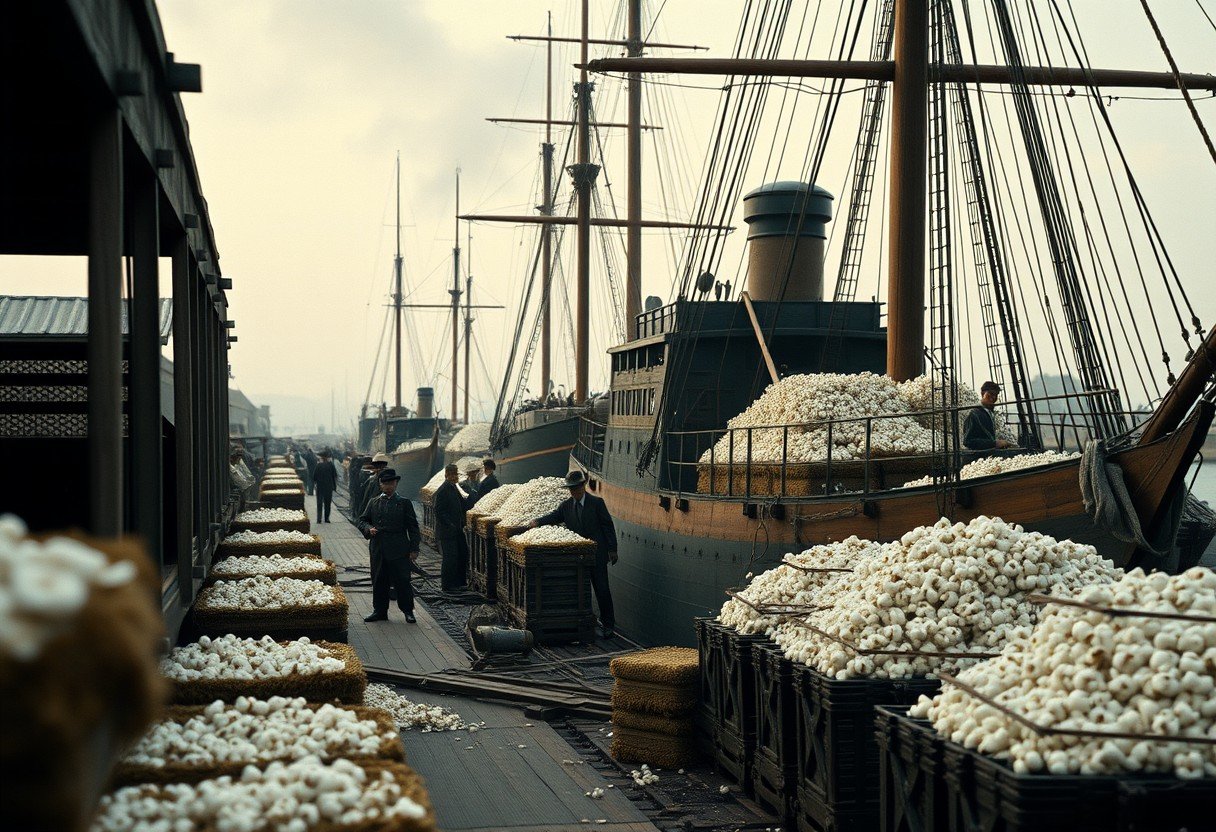By the mid-nineteenth century, the United States economy was undergoing a massive transformation. While the North was rapidly industrializing, the South’s economy was powered by agriculture. The most important export driving this growth was cotton, a cash crop that connected Southern plantations to global markets, particularly in Europe. This boom shaped the nation’s wealth, international relationships, and the deep social divisions that led to the Civil War.
The Economic Scene in Mid-1800s America
The United States in the mid-nineteenth century was a nation of contrasts. The economy was shifting from its agrarian roots toward an industrial future, but this change was not uniform across the country. This period saw incredible growth but also created deep economic and social divides between different regions.
The North was becoming a center for manufacturing and industry, while the South remained overwhelmingly agricultural. This economic divergence created a complex relationship where the industrial North and the agrarian South were both dependent on and in conflict with each other. This tension would shape American trade, politics, and society for decades.
Technological advancements, especially the expansion of the railroad, were crucial. Railroads connected the vast country, allowing raw materials like cotton to be transported to ports and finished goods from factories to reach new markets. This period saw the rise of several key industries that laid the groundwork for America’s future economic power.
- Textile Manufacturing: Primarily located in the North, these mills were major consumers of Southern cotton.
- Iron and Steel Production: This industry was essential for building the railroads and machinery that fueled growth.
- Transportation: The development of railroads and shipping was vital for moving goods across the nation and overseas.
This industrial growth created a dynamic national market, but it also highlighted the South’s reliance on a single agricultural system.
Why Cotton Became the King of Exports
By the 1850s, cotton had firmly established itself as America’s most valuable export. Several factors contributed to its rapid rise to dominance. The demand from the booming textile industries in Great Britain and the rest of Europe was immense, and the American South was perfectly positioned to meet it.
A key technological breakthrough was Eli Whitney’s invention of the cotton gin in 1793. This machine dramatically sped up the process of separating cotton fibers from their seeds, making large-scale cotton production profitable. Before the gin, this was a slow, labor-intensive process that limited how much cotton could be prepared for market.
The climate and soil of the Southern states were ideal for growing cotton. This allowed for the development of vast plantations dedicated to its cultivation. As a result, by the years leading up to the Civil War, cotton accounted for over half of all U.S. export earnings. This incredible economic power led to the popular Southern phrase, “Cotton is King.”
How Cotton Fueled the Nation’s Economy
The impact of cotton exports on the U.S. economy was profound and widespread. The wealth generated from the cotton trade did not stay in the South. It financed industrial development in the North, paid for imported manufactured goods, and drove investments in national infrastructure.
The entire country’s economic system became intertwined with cotton. Southern planters sold their cotton to buyers, who then shipped it on Northern-owned vessels to factories in Europe. The profits from this trade spurred the growth of American shipping, insurance companies, and financial institutions, many of which were based in Northern cities like New York.
However, this created a dangerous economic dependency. The nation’s prosperity became highly vulnerable to fluctuations in the global cotton market. Changes in international demand or disruptions to the supply chain could have severe consequences for the entire U.S. economy, a risk that would become terrifyingly real during the Civil War.
The Social Fabric of the Cotton Kingdom
The economic success of cotton came at a terrible human cost. The labor-intensive nature of cotton cultivation led to a massive expansion of slavery in the South. As the demand for cotton grew, so did the demand for enslaved people to plant, cultivate, and harvest the crop.
This reliance on forced labor created a rigid and unequal social structure in the South. A small class of wealthy plantation owners held most of the economic and political power, while the vast majority of the population, including enslaved individuals and poor white farmers, had little opportunity for advancement. This system of inequality became deeply entrenched in Southern culture and identity. The stark differences between the North’s wage-labor economy and the South’s slave-labor economy fueled growing regional tensions.
| Feature | The North | The South |
| Primary Economy | Industrial, Manufacturing, Trade | Agricultural, Plantation-based |
| Labor Force | Wage Labor, Immigrants | Enslaved Labor, Subsistence Farmers |
| Key Products | Textiles, Machinery, Manufactured Goods | Cotton, Tobacco, Grains |
| Infrastructure | Extensive Railroads, Canals, Ports | Limited Railroads, River Transport |
This table illustrates the fundamental divergence that shaped the cultural and political conflicts of the era, ultimately leading to social upheaval.
America’s Place in Global Trade
The dominance of cotton exports positioned the United States as a major player in the global economy. Vital trade relationships were established with industrial powerhouses like Great Britain and France, whose textile industries depended heavily on a steady supply of American cotton.
These economic ties heavily influenced foreign policy and international relations. European nations had a vested interest in the stability of the American South to ensure their industrial needs were met. This international dependence gave Southern leaders a sense of leverage, believing that their control over the cotton supply gave them significant power on the world stage.
This dynamic was dramatically altered by the Civil War. When the war disrupted the South’s cotton production and the Union blockaded Southern ports, European textile manufacturers faced a severe cotton shortage. This crisis forced them to seek alternative sources in places like Egypt and India. This shift demonstrated how geopolitical events could reshape global trade patterns and reduce the world’s dependency on a single source for a critical raw material.
Frequently Asked Questions about Mid-Nineteenth Century Exports
What was the most important U.S. export by the mid-1800s?
By the mid-nineteenth century, the most important export from the United States was cotton. It dominated the nation’s trade, accounting for more than half of all export revenue in the years before the Civil War.
Why was cotton so important to the American economy then?
Cotton was the engine of economic growth. It generated immense wealth for the South, funded industrialization in the North, and drove the development of infrastructure like railroads and shipping to transport it to global markets.
How did cotton exports affect slavery in the United States?
The massive demand for cotton directly led to the expansion and entrenchment of slavery in the South. The plantation economy relied on the forced labor of millions of enslaved people to remain profitable, which deepened social and racial inequalities.
Which country was the biggest buyer of American cotton?
Great Britain was the largest importer of American cotton. Its massive textile industry, a cornerstone of the Industrial Revolution, was almost entirely dependent on cotton cultivated in the American South.
What other products did the U.S. export during this time?
While cotton was the leader, the U.S. also exported other significant agricultural products like tobacco and grains such as wheat and corn. Additionally, as the North industrialized, a growing amount of manufactured goods and textiles were also sold abroad.









Leave a Comment